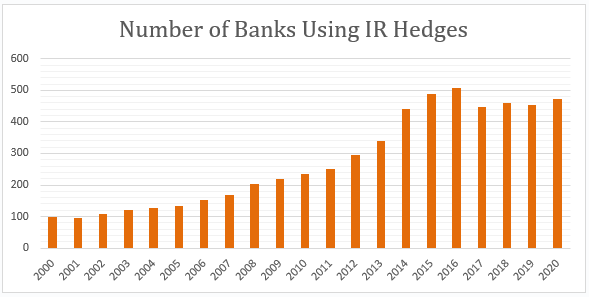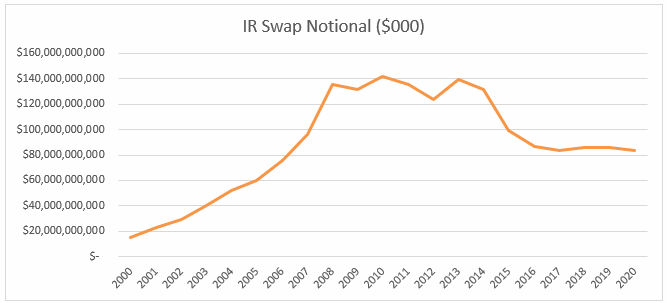Reasons For Community Banks to Embrace Loan Hedging in 2021
This year may be the right time for your bank to embrace a loan hedging program. With the economy recovering from a pandemic and the possibility of stoking inflation, banks that can offer borrowers more flexible loan structures may be in a better position to win more and better quality loans. While the Federal Reserve projects that the Fed Funds rate will increase in 2023, the market is now anticipating interest rate hikes in 2022. Why would a community bank consider a loan hedging program at this time?
Interest Rate Risk Hedging At Community Banks
Over the last ten years, more community banks have adopted some form of interest rate hedging. However, loan hedging is still much more acceptable at the national and larger regional banks. The graph below shows how many reporting depository institutions have some interest rate swaps on their balance sheet. Approximately 10% of all banks in the country have swap notionals on their balance sheet, and the majority of that notional is related to loan or deposit hedges.

More interestingly, while only 10% of banks by charter are using interest rate hedges, 89.4% of banks by asset size are using interest rate hedges. The graph below shows the notional volume of swaps for all banks in the country.

The takeaway from the numbers above is that only approximately 10% of the banks by asset size do not offer some form of loan hedging – and that number may be smaller as some banks use hedging programs where the derivative does not appear on the bank’s balance sheet. Not offering the option of an interest rate hedge to your borrower may be a competitive disadvantage to your bank.
Community Bank Motivation to Hedge
There are seven factors that motivate banks to use a loan hedging program.
- Mitigate Interest Rate Risk: Banks’ cost of funding and liquidity can change rapidly, and offering fixed-rate loans in a rising interest rate environment may be dangerous. A loan hedging program can mitigate that risk.
- Improve Credit Quality: Borrowers with current DSCR under 1.5X (the vast majority of small commercial borrowers in today’s market) do not demonstrate positive cash flow with a 200 or 300bps increase in the loan rate. With capitalization rates low, advance rates high, and the DSCR for the average commercial borrower of 1.10X to 1.30X, the credit risk of loan repricing is greater than ever.
- Competitive Pressures: With interest rates still low but rising, many commercial borrowers are seeking the longest fixed-rate term available to them. Banks that can accommodate borrowers’ demands have an improved chance of winning more high-quality loan business.
- Protect Existing Loans: Existing borrowers can be highly profitable clients for community banks. We observe that a large percentage of community banks are offering hedges to their best existing customers. Losing a new loan to a competitor may be a positive or negative ROE event for the bank (depending on the winning price/structure), but losing an existing loan to a competitor is almost always a highly negative ROE event for a community bank.
- Instilling Lending Discipline: Community banks face pressure to train lenders, to maintain consistent underwriting standards, and instill sensible pricing methodology. One positive aspect of a well-designed loan hedging program is that it highlights the importance of pricing loans to credit, interest rate risk, and the term structure of rates. Lenders that are taught to use hedging programs quickly appreciate the importance of disciplined pricing.
- Decrease Loan Prepayment Speeds: One of the biggest determinants of loan profitability is the prepayment rate. More stable loans with longer maturities are more profitable for banks. The amount of resources expanded by banks in sourcing, originating, and underwriting credits makes the initial day the loan is booked to be the least profitable in the life of that credit. Every periodic interest payment that the borrower makes serves to increase that loan’s value to the bank. The conditional prepayment rate on hedged loans (which can be 3% to 5%) is much lower than the average at community banks (some banks experience 25% to 35% loan prepayments per annum).
- Generate Fee Income: One of the main reasons that banks hedge loans for their clients is to generate fee income. Fee income for smaller hedged commercial loans is typically between 50 to 200bps of the loan amount and is commonly recognized immediately in the period received. This is a substantial amount of non-interest income available to banks when short-term interest rates make the NIM-driven banking model very challenging.
Conclusion
More and more community banks are finding loan hedging programs an important tool in not just managing risk but generating additional income and meeting their loan structuring and pricing strategies. Loan hedging cannot be a solution to every community bank customer. However, not having a loan hedging solution and not having experienced lenders trained on such a program can be a competitive disadvantage for a bank.

